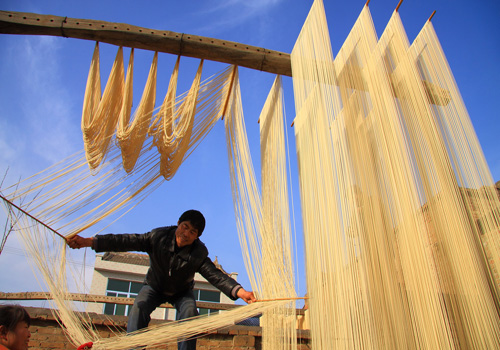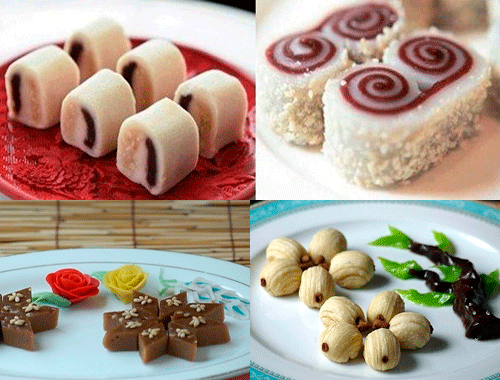A Bite of China II - Heart's Message, a way of transmitting Chinese food cooking
2014-05-09Cultures
Even one kind of food will have various flavors made by different people. Every recipe of Chinese food is so special and magical that cannot be easily learned. The transmission of culinary skills, no matter in remote mountain villages or in bustling cities, still follows the traditional way of teaching orally and understanding tacitly. Each delicacy is the result of culinary skills passing on from generation to generation, or transmitting from one to another, through wisdom of ancestors, secrets among family members or key points from masters, etc.
Oil is the media between cookware and foods in Chinese cooking. The discovery that vegetable oil is healthier and more readily available than animal fat made the human cuisine history a big step forward. Reap rapeseeds in spring days with signs of continuous sunny days coming, then seeds can be easily threshed after days of being shined. The life as plants end and rapeseeds then will start a fantastic trip. Frying seeds is the first step. High temperature breaks down their cell structures, ensuring fat separation easier. Ground rapeseeds together with straws are compressed into round oil bases. Rammer as heavy as one hundred kilograms continually beat the wooden wedge which indirectly exerts great pressure to the bases till oil bleeding out. Squeezing oil physically from rapeseeds, an ancient technology more than one thousand years old, may be the best inheritance of ancestors’ wisdom in the age of pursuing interests and efficiency. People today inherit not only this technology but also the usages of the oil. Huizhou Stinky Tofu, only be fried in rapeseed oil could it reach the fancy effect of smelling stinking but tasting good. “Red Oil”, the soul of Sichuan Cuisine, is just made from rapeseed oil, together with red peppers. Beautiful color, tempting spicy flavor and tantalizing smell of “Red Oil” puts the finishing touch of famous Sichuan food.

Sichuan Cuisine with “Red Oil”
The European archaeological discoveries show that breads in the most ancient age were made from starch extracted from ferns. Ancestors of the Yao nationality in Mangshan, a mountain village in central China’s Hunan Province, also found extracts of the plant could be made to cakes. Heat the fluid from fern roots to paste, stir constantly till gel formed on surface. Wrapped with dried starch and sprinkled with sugar and sesame seeds, the sweet Fern Root Cake can be eaten directly after being torn into small pieces. This is one of delicacies of the Yao people today, a gift from forefathers.

Fern Root Cake
Another delicacy inherited is Hanging Noodles in northwest China’s Shannxi Province. Fine weather, proper proportions of wheat flour, salt and water and timely procedures are all critical to ensure success of making this food. Each noodle can be elongated to three meters; totally over one hundred noodles are hung together on a stick to be dried by sun and air. The Loess Plateau is the birthplace of Chinese ancient civilizations, forefathers and elders of each cave-house want to leave or teach something to their younger generations.

Hanging Noodles in Shannxi
It is not surprising to see delicious foods made by cooks from the same family in China--that may explain the cooking secrets among family members. Some local cuisines in Shanghai are one of the representatives. Cooked ham thread, chicken breast and winter bamboo shoot are cut into thin shreds with diameter less than 0.5 mm, and then boiled together. During the cooking process the flavors of three ingredients release simultaneously and integrate into one to form the fresh dish Chicken, Mushroom, Ham Threads in Consomme. Another representative dish is Flash Fried River Shrimp. The whole cooking of it takes less than ten seconds, and an experienced cook know well that when the shrimps should be fished out from boiling oil to make sure them fully cooked but not hard-boiled. These excellent cutting skills, mastery of heating and other techniques in kitchen are transmitted among families.

Chicken, Mushroom, Ham Threads in Consomme
Master and apprentice, one of the most important Chinese traditional ethics of non blood relationship, plays an essential part in transmission of Chinese food cooking, which is quite obvious in making Suzhou-style cakes. The various types of cakes and high requirements on skills need strict teaching systems. Fine processing exists in every step of making these delicate cakes. Water glutinous rice and then grind; mix the wet flour with japonica rice flour in different proportions to create changeable tastes; add a variety of fillings and steam the cakes. Merely filling stuffing is a kind of knowledge. Mints are added in summers and autumns, while roses in winters and springs--pastry cooks want to make use of natural colors and fragrances according to different seasons. Moreover, sweetened bean paste, lotus seed paste, meat or other stuffing are wrapped depending on diverse taste requirements. Learning cooking skills of Suzhou-style cakes is a long-term experience, thus apprentices must constantly practice under masters’ teaching.

Suzhou-style Cakes
From hands to mouths and then to hearts, the Chinese always transmit the unique mode of perception to the world and life. As long as they light the fire and take up bowls and chopsticks, each ordinary one of them may involve in the creation of Chinese delicacies.
- By Sophy (VisitOurChina)
Preview:A Bite of China II - Footsteps, Accompanied By Familiar Hometown Flavors
Next:A Bite of China II - Seasons, diversified delicacies for different time




